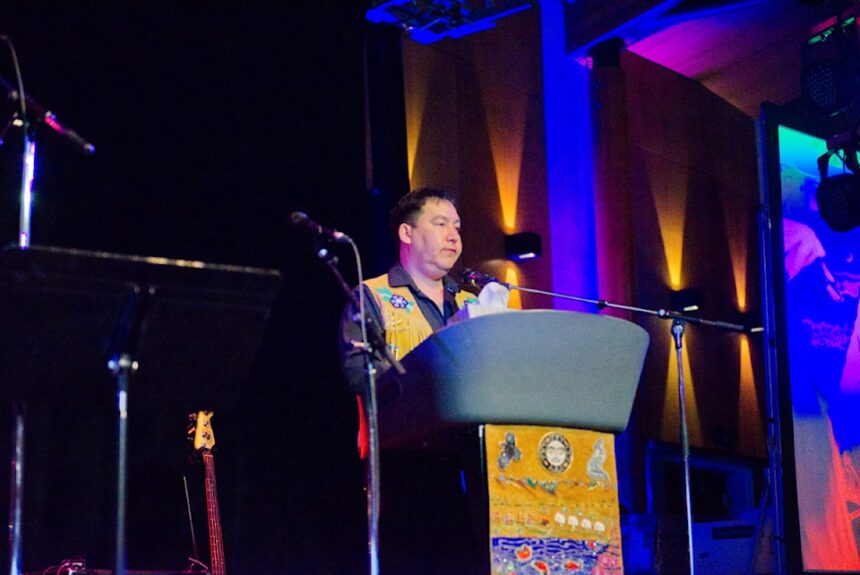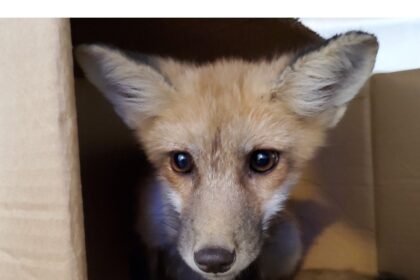The First Nation celebrated the milestone at the Kwanlin Dün Cultural Centre in Whitehorse on March 29, 2025 Chief Sean Uyenets’echᶖa Smith held a copy of Together Today For Our Children Tomorrow as he spoke to an audience assembled at the Kwanlin Dün Cultural Centre on March 29, 2025. The small orange book is the same document Elijah Smith and a delegation of Yukon First Nations leaders presented to Prime Minister Pierre Elliott Trudeau in 1973. That document laid out a vision, Smith told the News. “It was a vision based on the dreams and aspirations of First Nation people in the Yukon, but as well as our individual nations, you know, that we came from and how to kind of create those opportunities for their children, for citizens, but their children and their grandchildren and for each and every generation to come,” said Smith. This year marks 20 years since Kwanlin Dün First Nation signed its modern treaty and self-government agreement. The final agreement was signed on Feb. 19, 2005, and took effect on April 1 of that year. The First Nation celebrated the anniversary with a dinner on March 29, 2025, which was pared down from initial plans due to deaths in the community. Smith recalled growing up in the old village in Marwell – also known as Lot 226 – where First Nations citizens did not having running water or sewage. “At that time, in 1980s and 1990s, there’s a number of different reports that came out that really spelled out those challenges as to Kwanlin Dün, but Yukon First Nations people to gain opportunities, to advance their their interests, to be able to, you know, get jobs and employment and provide for their families,” said Smith. Most of the First Nations in the territory signed final and self-governing agreements with the governments of the Yukon and Canada during the 1990s and 2000s. “What this means for just average, everyday Yukoners, we have some of the leading, leading agreements, leading ideas of to advance reconciliation in the world, here, and that’s really an amazement and accomplishment that we can be proud of,” said Smith. The final agreements define the rights of First Nations on settlement land and on traditional territory. They also outline rights and obligations of all governments involved regarding fish and wildlife, resources, taxation, financial compensation, and economic development. Self-government agreements, which were signed alongside final agreements, laid out what powers each First Nation had at their disposal in regards to enacting laws, taxes, land and resource management, and services, as well as funding provisions. As there are set to be both federal and territorial elections this year, Smith said there are opportunities to build relationships with governments of the day. He said that there are important conversations to have when it comes to perspectives and interpretations of the agreements. Now, as children raced through the halls of the cultural centre, Kwanlin Dün families are healthier, he said. “Families are becoming more well, and when families become well, we see young people do well,” said Smith. He said the First Nation’s priorities for the coming years will focus on education supports in school, social aspects including sports and opportunities, and advancing the interests of the next generation. Referring back to the copy of Together Today for Our Children Tomorrow, Smith said it’s about looking ahead for the next generation. “This is over 50 years ago, and so for those leaders and others at that time to think ahead and dream, and the meanings of those dreams meant a whole lot for people on an individual level. So I think the sky’s the limit, and opportunities are going to come to us.” Contact Talar Stockton at talar.stockton@yukon-news.com
Friday, 14 Nov 2025
Canada – The Illusion
Search
Have an existing account?
Sign In
© 2022 Foxiz News Network. Ruby Design Company. All Rights Reserved.
You May also Like
- More News:
- history
- Standing Bear Network
- John Gonzalez
- ᐊᔭᐦᑊ ayahp — It happened
- Creation
- Beneath the Water
- Olympic gold medal
- Jim Thorpe
- type O blood
- the bringer of life
- Raven
- Wás’agi
- NoiseCat
- 'Sugarcane'
- The rivers still sing
- ᑲᓂᐸᐏᐟ ᒪᐢᑿ
- ᐅᑳᐤ okâw — We remember
- ᐊᓂᓈᐯᐃᐧᐣ aninâpêwin — Truth
- This is what it means to be human.
- Nokoma











